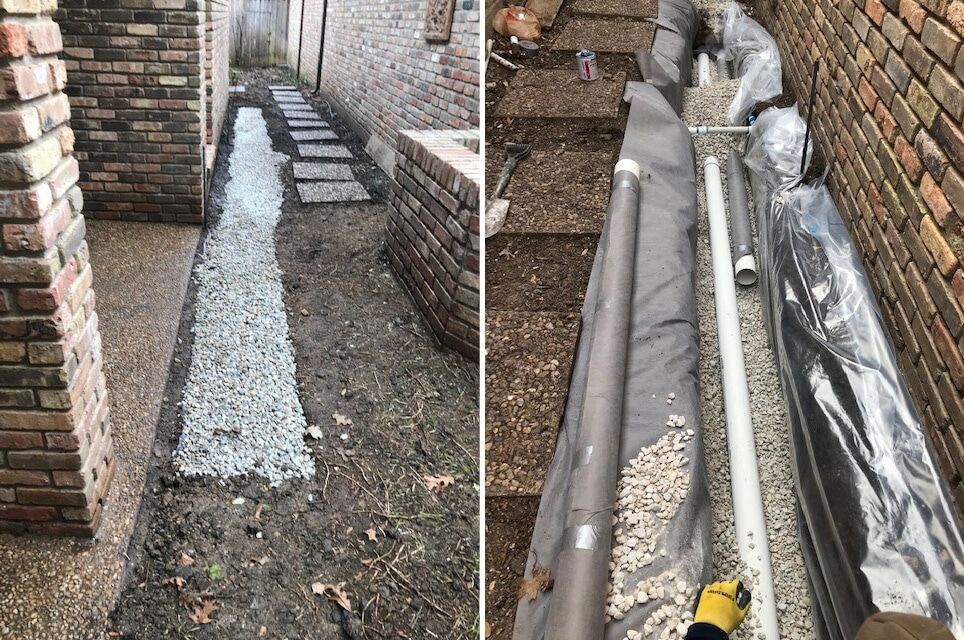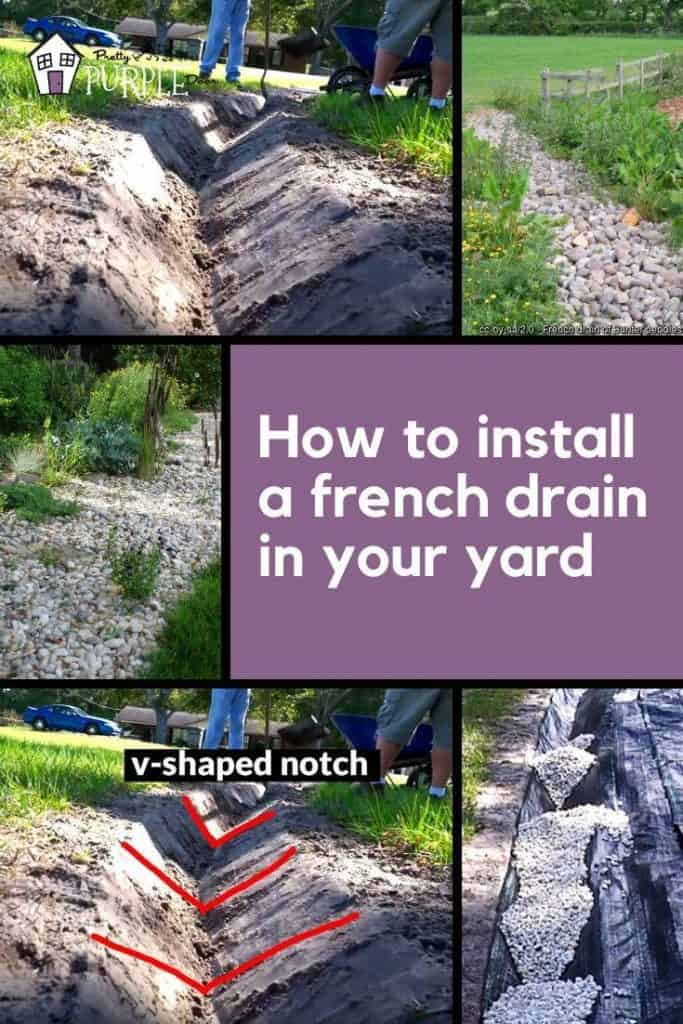The Important Overview to Maintaining Your French Drainpipe for Resilient Efficiency
Keeping your French drain is vital to its performance and your residential or commercial property's security. Regular checks can conserve you from expensive fixings and water damages. You'll would like to know what indicators to search for and just how often to inspect your system. Plus, understanding the cleaning procedure can make a substantial difference. Let's explore the important steps for guaranteeing your drainpipe operates well for many years ahead.
Understanding the Feature of a French Drainpipe
A French drain is a critical component in taking care of water around your home. It guides excess water far from your structure, avoiding flooding and damages. When heavy rain drops, the drain accumulates water through a perforated pipe hidden in gravel. This system permits water to move freely, decreasing pressure on your cellar walls and lessening the risk of leaks.You could wonder exactly how it works in technique. As water fills the soil, gravity draws it towards the drain. The perforated pipeline records this water, transporting it to a designated drainage location or storm sewage system. This procedure maintains your lawn completely dry and safeguards your home's architectural integrity.Understanding exactly how a French drainpipe functions is crucial to appreciating its significance. By properly transporting water away, it assists keep a risk-free and dry living environment. Maintaining your French drain in top problem assurances you avoid costly repairs down the line.
Regular Inspections: What to Look For
When you're checking your French drain, start by checking for any obstructions that could be obstructing water circulation. Take note of signs of surface disintegration around the drain, as this can suggest potential issues. Routine assessments will aid keep your drainage system working properly.
Obstructed Drainpipe Assessment
Just how can you inform if your French drain is clogged? Watch for water merging in your lawn, particularly after hefty rainfall. That's a red flag if you see areas where water gathers instead of draining pipes. You must additionally inspect the drain electrical outlet; if water isn't spurting as it should, there's likely a blockage. Pay attention for unusual gurgling noises, which can indicate trapped air. In addition, check the drain's surface for any type of greenery growth, as roots can penetrate and clog the system. If you scent mildewy odors, it might direct to stationary water created by an obstruction. Frequently assessing these signs can aid you maintain your French drain effectively and stop costly fixings.
Surface Erosion Inspect

Cleaning Your French Drain: Step-by-Step Guide
Cleansing your French drainpipe is crucial for maintaining it operating effectively. You'll require some specific devices and a clear process to guarantee everything runs efficiently. Allow's stroll through the steps and tips for keeping your drainpipe properly.
Tools You'll Require
To deal with the job of cleansing your French drainpipe properly, you'll wish to gather a few essential tools. Order a durable pair of handwear covers to shield your hands from particles and sharp things. A small shovel or trowel will certainly help you eliminate dust or clogs around the drainpipe. For clearing out the interior, a plumber's snake or a high-pressure water nozzle can be incredibly helpful. You'll additionally require a pail for collecting any debris you draw out. Ultimately, having a yard tube handy will certainly make it easier to rinse out the drain and assure it's streaming smoothly. With these tools ready, you'll be established for an extensive cleaning session!
Cleaning Refine Actions
Begin by examining the area around your French drain for any kind of noticeable debris or blockages. Get rid of fallen leaves, branches, or dirt that may block water circulation. Next, check the inlet and electrical outlet areas; clear any blockages to ensure appropriate drainage. Make use of a garden hose to purge the drainpipe, directing water right into the inlet. This aids remove any accumulated sludge or debris. Take into consideration utilizing a plumbing's snake to damage them up if you notice relentless obstructions. After cleaning, inspect the gravel around the drainpipe; replenish it if it's gotten rid of. Confirm the drainpipe covers are intact and firmly in location to protect against debris from getting in. Regular cleaning maintains your French drain working efficiently.
Upkeep Frequency Tips
While routine upkeep is necessary for your French drainpipe's longevity, recognizing how usually to preserve it can make all the distinction. Preferably, you should check your French drainpipe at the very least twice a year, preferably in springtime and loss. After heavy rainfall or snowmelt, look for clogs or particles. If you discover any type of standing water, it's time to cleanse your drain.In locations with hefty foliage, more regular upkeep-- about every three months-- may be essential. Additionally, think about cleaning your French drainpipe after significant tornados or if you observe water merging in your backyard. By staying proactive, you'll ensure your French drainpipe features properly and secures your residential property from water damages. Normal checks will certainly conserve you money and time over time.
Determining Typical Problems and Their Solutions
It's vital to identify common issues with your French drain and execute efficient services when you observe water merging in your backyard or damp places in your cellar. One constant issue is blocking, commonly More about the author brought on by debris like leaves or debris. To repair this, you can utilize a plumbing serpent or a high-pressure water jet to clear blockages.Another concern may be inappropriate incline. If your drain isn't sloped correctly, water won't flow far from your home. You can change the slope by excavating and rearranging the drainpipe pipe.Lastly, check for damages or splits in the drainpipe itself. If you discover any type of, replacing the harmed areas is essential for peak performance. By resolving these problems quickly, you'll aid ensure that your French drain proceeds to work effectively, shielding your property from water damages and maintaining a completely dry, risk-free setting.
Seasonal Maintenance Tips for Your French Drainpipe
Attending to common concerns with your French drain is simply the very first step in guaranteeing its lasting efficiency. Seasonal maintenance is crucial for peak performance. In the spring, eliminate leaves and debris that might have collected during winter months. Look for any blockages in the electrical outlet or catch container, as water requires a clear path to move freely.During summertime, inspect your drain for any kind of indications of working out or changing soil. Ensure it's still degree and functioning effectively. As fall strategies, tidy out any kind of dropped leaves to prevent obstructions before winter arrives.In winter, look for freezing temperatures. Make certain your drainpipe isn't at danger of cold if you live in a cool environment. Insulating exposed pipes can help. Routine checks and timely maintenance can stop expensive fixings and maintain your French drainpipe functioning effectively year-round. Stay proactive and delight in comfort understanding your drain system is in great shape!
When to Call a Professional
When to call in a specialist can save you time and avoid further damages to your French drainpipe, knowing. It's a clear indicator that your drainpipe may be blocked or damaged if you notice consistent standing water in your backyard. Don't ignore odd odors, as they can indicate sewer backup or decay, which calls for instant attention.If you find that your drainpipe isn't working appropriately after attempts to tidy or preserve it, it's time to reach out for specialist assistance. Furthermore, if you're unsure concerning the underlying problems or do not have the needed tools, working with an expert can offer tranquility of mind.Finally, if your French drain is old or has actually experienced considerable wear and tear, specialist assessment can determine whether fixings or complete substitute is needed. Trust fund the professionals to assure visit the site your drain system functions effectively for several years to find.
Tips for Avoiding Future Water Drainage Problems
To maintain your French drain working efficiently, routinely checking and keeping it can make all the difference. Beginning by clearing particles, leaves, and dust from the surface and drainpipe openings. This prevents blockages that can bring about water backup. Inspect the crushed rock around the drain; if it's compacted or deteriorated, consider adding fresh crushed rock to keep optimal flow.Next, draw away water far from your drain by making sure downspouts and gutters are clear and guiding water at the very least 3 feet away from your structure. Consistently evaluate for any type of indicators of damage or sagging. If you discover concerns, address them immediately.Finally, consider installing a filter or a catch basin to catch bigger particles before it goes into the my review here drain. By remaining proactive with these pointers, you'll reduce the danger of future drain issues and maintain your French drainpipe in leading shape.
Often Asked Concerns
The length of time Does a French Drain Commonly Last?
A French drainpipe typically lasts around 30 to 40 years, depending upon the products used and maintenance (Portland French Drain). If you maintain up with regular checks, you can expand its life expectancy even further
Can I Mount a French Drainpipe Myself?
Yes, you can mount a French drain on your own if you've got the right tools and expertise. Just make sure to plan thoroughly, comply with neighborhood guidelines, and warranty correct drainage to prevent future issues.
What Materials Are Used in a French Drainpipe?
You'll need perforated pipeline, gravel, landscape material, and a solid water drainage pipe for your French drain. These materials assist redirect water effectively, avoiding flooding and keeping your home risk-free and completely dry from water damage.

Is an Authorization Required to Install a French Drainpipe?
You'll likely require an authorization to set up a French drainpipe, depending on neighborhood laws. Inspect with your community to assure you adhere to any kind of needed guidelines and stay clear of potential issues throughout setup.
What Are the Prices Connected With French Drainpipe Upkeep?
Keeping a French drainpipe commonly sets you back in between $100 and $500 every year. You'll need to take into consideration expenses for cleaning, fixings, and examinations. Normal upkeep helps avoid larger assurances and expenses your system functions effectively for several years - Portland French Drain. When you're checking your French drain, start by examining for any type of clogs that could be obstructing water flow. By remaining positive, you'll guarantee your French drainpipe functions effectively and shields your building from water damages. When you notice water merging in your lawn or damp spots in your cellar, it's vital to recognize typical problems with your French drain and apply efficient solutions. You can change the slope by excavating and repositioning the drainpipe pipe.Lastly, check for damages or fractures in the drainpipe itself. Inspect the crushed rock around the drain; if it's compressed or eroded, take into consideration adding fresh crushed rock to maintain excellent flow.Next, divert water away from your drainpipe by guaranteeing seamless gutters and downspouts are clear and routing water at least 3 feet away from your structure